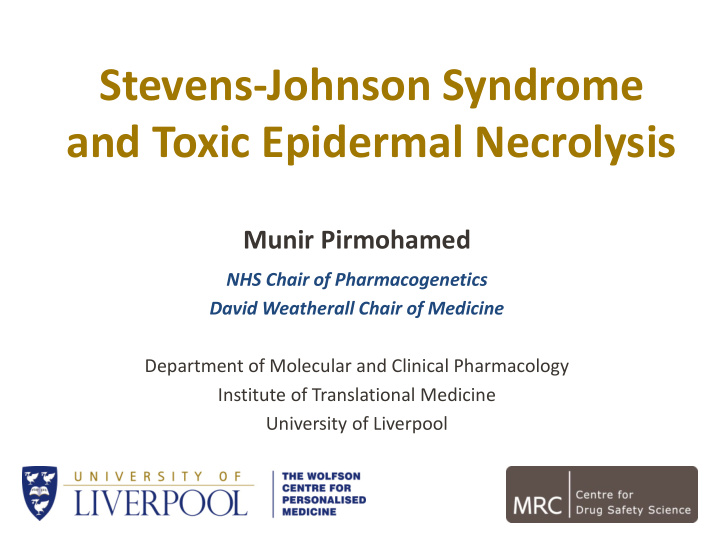



Stevens-Johnson Syndrome and Toxic Epidermal Necrolysis Munir Pirmohamed NHS Chair of Pharmacogenetics David Weatherall Chair of Medicine Department of Molecular and Clinical Pharmacology Institute of Translational Medicine University of Liverpool
MRC Centre for Drug Safety Science: Mission To use the critical mass and knowledge in drug safety science that we have now accrued within the Centre: to undertake leading edge science, and train the next generation of drug safety scientists to understand the fundamental mechanisms of clinically important, and currently relevant, adverse drug reactions to develop strategies to improve the benefit-risk ratio of current and new medicines, for the benefit of patients, industry and regulators.
iSAEC’s Mission Serious Drug-Induced cutaneous Liver Injury adverse reactions “The iSAEC will identify DNA variants useful in QT prolongation- Osteonecrosis of torsades de understanding the the Jaw pointes risk of drug induced serious adverse events.” Antipsychotic- Drug-induced induced weight renal injury gain
InTernational Consortium on Drug Hypersensitivity (ITCH) 12 international centres EU 50 UK centres 1500 patients EUDRAGENE Australia Canada Norway Sponsored by the International Serious Adverse Event US Croatia Consortium (iSAEC) Brazil
SJS/TEN Patients DRUGS SJS/TEN ALLOPURINOL 10 AMOXICILLIN 16 AMOXICILLIN/CLAVULANIC ACID 5 AMPICILLIN 2 BACAMPICILLIN 1 CARBAMAZEPINE 33 LAMOTRIGINE 18 OTHERS 100 PHENYTOIN 11 SULFASALAZINE 6 TRIMETHOPRIM/SULFAMETHOXAZOLE 26 Total 227 177 Caucasians Cases 5
All Caucasian SJS/TEN cases 177 cases, 9237 controls Low frequency HLA-B allele Protein kinase
ITALIAN SJS/TEN cases: 40 cases, 1203 controls HLA-B allele OR 133 (25-709); P=1.02 x 10 -8
SJS/TEN: No Other Population Specific Signals North Europeans: 116 cases, 5315 controls Spanish population: 21 cases, 2622 controls
SJS Allopurinol analysis: 9 Caucasian SJS cases SNP CHR BP ODDS Pvalue L95 U95 FreqCasesFreqContrFreq1kg rs144129294 6 30406608 568 2.46E-09 70.66 4565 0.1111 0.000379 0.001 rs150364710 6 30428647 568 2.46E-09 70.66 4565 0.1111 0.000379 0.001 rs116203030 6 30279907 488.7 3.28E-09 62.86 3800 0.1111 0.000379 0.002 rs151052569 6 30365915 672 5.86E-09 75.05 6017 0.1111 0.000379 0.001
TRIMETHOPRIM/SULFAMETHOXAZOLE 17 north European SJS cases 5315 controls Common Genome wide significant hits on chr13 and chr6 Uncommon genome wide significant hits on chr3 Borderline genome wide significant hits on chr22 and chr21
Nevirapine Hypersensitivity in Malawi NVP treated Malawian HIV patients included: 182 NVP-tolerant controls 151 Hypersensitive patients – 56 Rash – 23 DRESS – 51 SJS/TEN – 21 DILI GWAS and proteomic studies HMGB1 – total and isoforms that stratify according to both mechanism of release (acetylation status) and function (redox status)
Nevirapine-Induced SJS/TEN 51 SJS/TEN and 182 Tolerant controls Logistic Regression with CD4+ cell count as covariate Imputed using 1K genomes phase I data HLA-C
NVP-Induced SJS/TEN: Replication Replication Cohort 11 SJS/ TEN and 59 Tolerant controls (Malawian and Ugandan) Additional Cases 27 SJS/ TEN (Mozambique)* Initial top hit:rs5010528 (HLA-C) Logistic Regression Meta-analysis Cohort n MAF p OR (95%CI) p OR (95%CI) Discovery Case 51 0.36 1.48x10 -6 4.64 (2.48-8.66) Control 182 0.14 Replication Case 11 0.36 4.31x10 -8 0.008 5.63 (1.56-20.35) 4.81 (2.74-8.44) Control 59 0.12 Replication Case 38 0.38 9.6x10 -5 2.69x10 -10 6.40 (2.66-15.43) 5.17 (3.10-8.59) +additional Control 59 0.12 *Borgiani et al 2012 Eur J Clin Pharmacol. 2013 Nov;69(11):1909-16
HLA-C 3D Protein Structure Amino Acid 73 is within the a1 subunit (yellow) of the peptide recognition site. p.A73E p.A73E Top Side
Nevirapine forms protein adducts in patients Nevirapine His146 RH(NVP)PYFYAPELLFFAK y8 y1 y2 y3 y4 y6 y7 proline Lysine Alanine Phenylalanine Phenylalanine Leucine Glutamic acid y5 b4 b2 Leucine Tyrosine+NVP His+NVP 100 200 300 400 500 600 700 800 900 100 Mass/Charge, Da
Summary iSAEC as private-public partnership has worked well, and has managed to recruit well phenotyped patients Genome-wide approaches are now beginning to bear fruit with several hits identified Global collaboration is important to further some of these findings Genomic studies will identify predisposing loci, but other studies also important to identify diagnostic and prognostic biomarkers Acknowledgements 1. iSAEC – Paola Nicoletti, Yufeng Shen, Arthur Holden and many others 2. iSAEC collaborators – contributed cases and adjudication (Shear, Friedmann) 3. Malawi team – Carr, Chaponda, Khoo, Lalloo and others
Recommend
More recommend